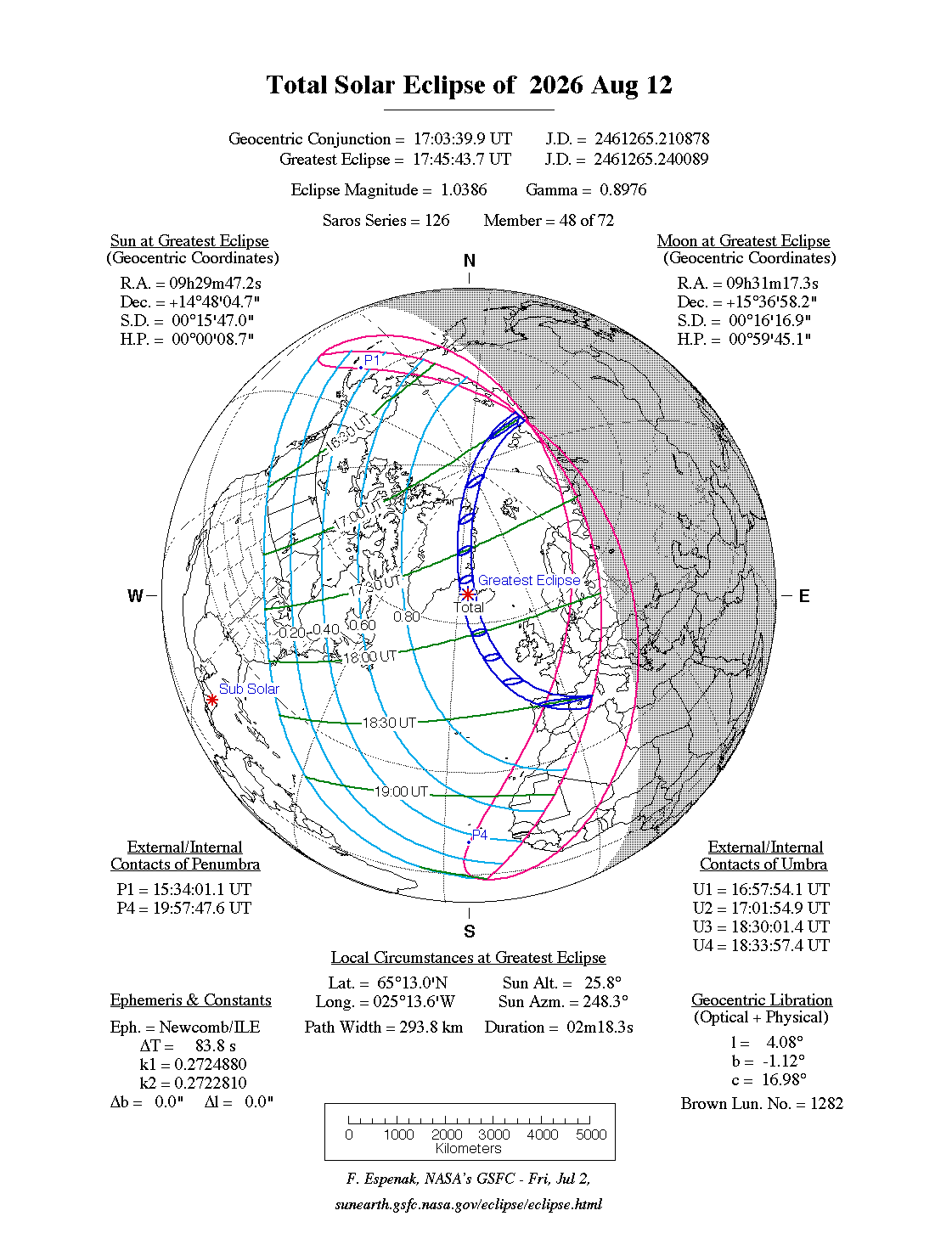A total eclipse of the Sun occurs on Wednesday 12 August, 2026 UT, lasting from 15:34–19:57 UT. A dramatic total eclipse will plunge the Sun into darkness for 2 minutes and 18 seconds at maximum, creating an amazing spectacle for observers in a very broad path, 294 km wide at maximum. It will be seen north-eastern Greenland, west Iceland, Spain, and the Balearics. The partial eclipse will be visible Canada and parts of the northern US, and western Europe and north Africa.
The timings of the phases of the overall eclipse
worldwide are as follows. In any particular
place it will be seen for a significantly shorter
duration as the shadow moves across the Earth:
| Partial eclipse begins: |
15:34:01 UT |
| Total eclipse begins: |
16:57:54 UT |
| Maximum eclipse: |
17:45:44 UT |
| Total eclipse ends: |
18:33:57 UT |
| Partial eclipse ends: |
19:57:48 UT |
During this eclipse the Sun will be 0.526° in apparent
diameter, 1.3% smaller than average. The Moon will be just 2 days past perigee, making it relatively large.
At the start and end of the eclipse the Moon
will be 0.542°, and at maximum eclipse 0.547°,
which is 2.9% larger than average; hence it will cover the Sun,
making this a total eclipse.
The statistics page has information on the ranges of the sizes of
the Sun and Moon, and the Moon data page displays detailed
information on the Moon's key dates.
The North
The total eclipse path starts on the far northern coast of Siberia, then crosses the Arctic ocean, reaching the northern coast of Greenland at 17:16 UT. It passes down eastern Greenland, and then crosses over to Iceland, with the path of totality hitting the north-west coast around 17:44 UT. The centre line does not touch Iceland, but viewers down the west coast should still see a memorable total eclipse; Reykjavik is too far to the east to see more than a few seconds of totality, however, so getting as far west as possible is the best course.
Spain
The total eclipse leaves Iceland about 17:50 UT, then skirts around the British Isles to reach Spain's northern coast at around 18:27 UT. The centreline runs from Oveido, at 18:28 UT, to the coast of the Balearic Sea, between Barcelona and Valencia, at about 18:31 UT. It crosses right over Mallorca at around 18:32 UT and finishes in the sea just moments later.
Interactive Map
This map shows the visibility of the eclipse.
The shaded area will see the total solar eclipse; however, near the edges of
this area, the eclipse will be very short. The bold line shows the centre
of the path, where the eclipse will last longest, so this is where you want to be if possible.
Use the zoom controls to zoom in and out; hover your mouse over any
point on the centreline to see the time and
duration of the eclipse at that point. You can pan and zoom the map to
see detail for any part of the eclipse path.
The interactive map is currently not available.
Overview Map
This map sourced from NASA Goddard Space flight Center: GSFC Eclipse Web SiteGSFC Eclipse Web Site
The primary source of all the information on eclipses presented here at Hermit Eclipse. (NASA Goddard Space flight Center)
shows the visibility of the total solar eclipse. It also shows the broader area in which a partial eclipse will be seen. (Click on it for the
full-sized version.)
Eclipse Season and Saros Series
This eclipse season contains 2 eclipses:
This is the 48th eclipse in solar Saros series 126.The surrounding eclipses in this Saros series are:
This Saros series, solar Saros series 126,
is linked to lunar Saros series 119. The
nearest partner eclipses in that series are:
Eclipse Parameters
| UT Date/time (max) | 17:45:51 on 12 Aug UT |
TDT Date/time (max) | 17:47:06 on 12 Aug TDT |
| Saros Series | 126 |
Number in Series | 48 |
| Penumbral Magnitiude | |
Central Magnitiude | 1.0386 |
| Gamma | 0.8977 |
Path Width (km) | 294 |
| Delta T | 1m15s |
Error | ± 0m09s (95%) |
| Penumbral Duration | |
Partial Duration | |
| Total Duration | 2m18s |
| |
| Partial Rating | major |
Total Rating | travel |
| Sun Distance | 151586229 km (92.9%) |
Moon Distance | 366979 km (21.0%) |
| Sun Diameter | 0.526° |
Moon Diameter | 0.542° - 0.547° |
| Perigee | 11:19 on 10 Aug UT |
Apogee | 08:21 on 22 Aug UT |
| Contact p1 | 15:34:01 on 12 Aug UT |
Contact p2 | |
| Contact u1 | 16:57:54 on 12 Aug UT |
Contact u2 | 17:01:55 on 12 Aug UT |
| Max eclipse | 17:45:44 on 12 Aug UT |
| Contact u3 | 18:30:01 on 12 Aug UT |
Contact u4 | 18:33:57 on 12 Aug UT |
| Contact p3 | |
Contact p4 | 19:57:48 on 12 Aug UT |
Note that while all dates and times on this site (except
where noted) are in UT, which is within a second of civil time,
the dates and times shown in NASA's eclipse listingsGSFC Eclipse Web Site
The primary source of all the information on eclipses presented here at Hermit Eclipse. (NASA Goddard Space flight Center)
are in the TDT timescale.
The Sun and Moon distances are shown in km, and as a
percentage of their minimum - maximum distances; hence 0%
is the closest possible (Earth's perihelion, or the
Moon's closest possible perigee) and 100% is
the farthest (aphelion, the farthest apogee).
The statistics page has information on the ranges of sizes
of the Sun and Moon, and the Moon data page displays detailed
information on the Moon's key dates.
Data last updated: 2015-09-17 04:54:30 UTC.

